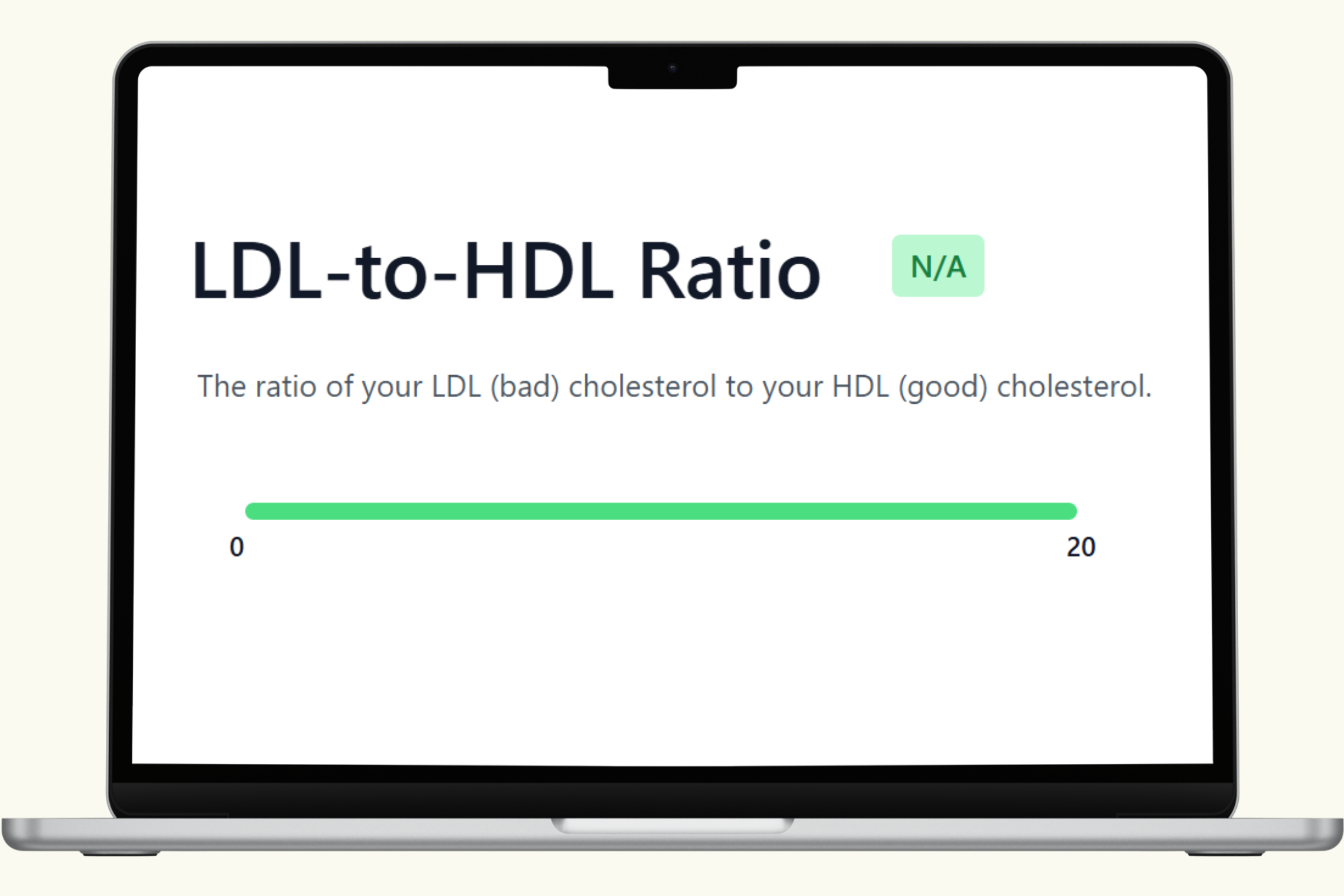LDL to HDL Ratio Blood Test
The LDL to HDL (LDL:HDL) ratio is a powerful tool for evaluating cardiovascular health. While many people are familiar with LDL (“bad” cholesterol) and HDL (“good” cholesterol) on their own, the ratio between them offers a more precise picture of heart disease risk. This marker highlights how much cholesterol is being delivered to tissues compared to how much is being removed, making it an essential measure for anyone looking to take charge of their heart health.
As part of the PlexusDx Diabetes & Heart Health Blood Test, the LDL:HDL ratio can be easily measured at home using a dried blood spot (DBS) sample on an ADX card. With this convenient method, you gain access to clinically validated insights without the need for a lab visit.
What the LDL:HDL Ratio Measures
This ratio compares low-density lipoprotein (LDL) cholesterol, which transports cholesterol to tissues (and can build up in artery walls), to high-density lipoprotein (HDL) cholesterol, which carries excess cholesterol away from the arteries and back to the liver for elimination.
- LDL Cholesterol (“Bad” Cholesterol): Can contribute to plaque buildup in arteries, raising the risk of atherosclerosis, heart attack, and stroke.
- HDL Cholesterol (“Good” Cholesterol): Helps clear cholesterol from the bloodstream, protecting arteries from damage.
- LDL:HDL Ratio: Indicates the balance between cholesterol delivery and removal. A lower ratio is generally protective, while a higher ratio signals increased cardiovascular risk.
Why the LDL:HDL Ratio is Important
Looking at LDL or HDL alone does not tell the full story. For example, someone with moderately elevated LDL might still be at low risk if they also have high HDL levels. Conversely, someone with only modestly raised LDL but very low HDL may face significant cardiovascular risk. The LDL:HDL ratio integrates both factors, giving a clearer measure of risk for heart disease, stroke, and metabolic issues.
Reference and Functional Ranges
While ranges can vary slightly across labs, the following cutoffs are commonly used:
- Optimal: Below 2.0
- Desirable: 2.0 – 3.0
- Borderline Risk: 3.0 – 4.0
- High Risk: Above 4.0
In functional and preventive medicine, the goal is often to keep the LDL:HDL ratio as close to 2.0 (or lower) as possible for long-term cardiovascular protection.
Specimen Collection Method
The PlexusDx Diabetes & Heart Health Blood Test uses an at-home dried blood spot collection on an ADX card. With just a quick finger prick, you collect a few drops of blood onto the card, which is then mailed to the lab. This method is:
- Convenient and non-invasive
- Clinically reliable and accurate
- Ideal for ongoing monitoring
- Shipped directly to your door for at-home use
Factors That Affect the LDL:HDL Ratio
Several lifestyle, genetic, and medical factors can shift your ratio up or down:
- Diet: Diets high in saturated fat, trans fat, and refined carbohydrates can raise LDL. Diets rich in omega-3 fats, fiber, and plant sterols can lower LDL and raise HDL.
- Exercise: Aerobic activity and resistance training improve HDL levels and overall lipid balance.
- Weight: Excess weight is linked to higher LDL and lower HDL, while weight loss usually improves the ratio.
- Smoking: Reduces HDL, worsening the ratio.
- Alcohol: Light to moderate intake may raise HDL, but excessive alcohol intake increases LDL and triglycerides.
- Genetics: Some people inherit lipid metabolism patterns that influence both LDL and HDL levels.
- Medical Conditions: Diabetes, insulin resistance, metabolic syndrome, and hypothyroidism are associated with unfavorable LDL:HDL ratios.
How to Improve the LDL:HDL Ratio
Fortunately, there are proven strategies to improve your cholesterol balance and reduce cardiovascular risk:
- Follow a heart-healthy diet: Choose whole grains, fruits, vegetables, legumes, nuts, and fatty fish while minimizing processed foods and trans fats.
- Exercise regularly: At least 150 minutes of moderate-intensity aerobic activity per week, plus strength training, supports better HDL levels.
- Manage weight: Even modest weight loss can significantly improve the ratio.
- Quit smoking: HDL often improves quickly after quitting.
- Moderate alcohol intake: A small amount may benefit HDL, but excess is harmful.
- Medications when necessary: Statins, PCSK9 inhibitors, and other drugs may be prescribed if lifestyle adjustments alone are not enough.
Why Monitor Regularly?
Cardiovascular risk is not static. Lifestyle changes, aging, and medical conditions all influence cholesterol levels and ratios over time. By monitoring your LDL:HDL ratio regularly with the PlexusDx Diabetes & Heart Health Blood Test, you can:
- Track the effectiveness of diet and exercise programs
- Assess your progress after weight loss or smoking cessation
- Monitor the impact of medications
- Catch early warning signs of cardiovascular risk
Take Control of Your Heart Health
The LDL:HDL ratio is one of the clearest indicators of cardiovascular risk, offering insights that total cholesterol or LDL levels alone cannot provide. With the PlexusDx at-home testing solution, you can gain valuable knowledge about your cholesterol balance and take proactive steps to protect your heart and metabolic health. Whether through lifestyle improvements, medical support, or both, knowing your LDL:HDL ratio empowers you to make informed decisions and reduce your long-term risk of heart disease.

Share:
Glucose Blood Test
Cholesterol-HDL Ratio Blood Test